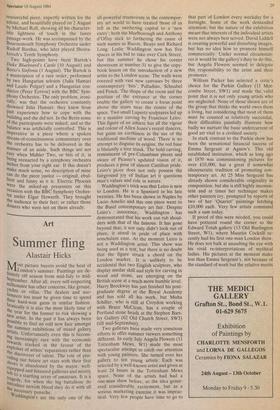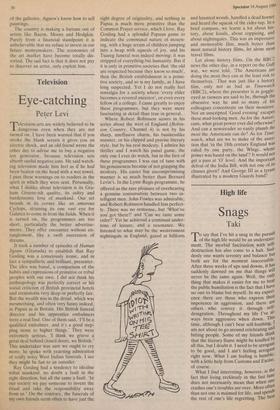Art
Summer fling
Alastair Hicks
Most picture buyers avoid the heat of London's summer. Paintings are de- finitely off season from mid-July to mid- September. After all, every self-respecting Millionaire has other concerns, like grouse, Yachts or villas. The dealers and auc- tioneers too must be given time to spend their hard-won gains in similar fashion. Ironically it is also the most likely time of the Year for the former to risk showing a new artist. In the past it has always been Possible to find an odd new face amongst the summer exhibitions, of mixed gallery artists. Unfortunately even this is becom- ing increasingly rare with the economic rewards stacked in the favour of the exploiter of artists' reputations rather than the discoverer of talent. The role of pro- vlding our future art stars with their first shows is abandoned by the major, well- el quiPPed and fidanced galleries and mostly ft to a startling array of amateurs. It is a tragedy, for when the big battalions do introduce newish blood they do it with all the necessary panache. Waddington's are the only one of the
all-powerful triumvirate in the contempor- ary art world to have treated those of us left in the sweltering capital to a new entry'; both the Marlborough and Anthony d'Offay stick to furthering the cause of such names as Bacon, Beuys and Richard Long. Leslie Waddington now has five spaces in his bid to take over Cork Street, but this summer he chose his corner showroom at number 31 to give the copy- book lesson on the introduction of a new artist to the London scene. The walls were covered with vast new canvases by three contemporary 'hits', Palladino, Schnabel and Penck. The shape of the room and the position of the entrance at the corner enable the gallery to create a focus point above the stairs near the centre of the space. Two small Lupertz sculptures led up to a massive carving by Francisco Leiro. This figure of an athlete has all the vigour and colour of Allen Jones's recent dancers, but gains an earthiness in the use of the traditional medium of wood. There is no attempt to disguise its origins; the red base is blatantly a tree trunk. The bold carving, reminiscent of pre-Columbian pieces and aware of Picasso's updated vision of it, produces a pose of almost Castilian pride. Leiro's pi.ice does not only possess the fairground joy of Indian art it questions man's values and role in nature.
Waddington's trick was that Leiro is new to London. He is a Spaniard in his late twenties. He has been shown in Naples by Lucio Amelio and this one piece went to the Basel contemporary art fair. Despite Leiro's innocence, Waddington has demonstrated that his work can rub shoul- ders with that of the famous. It has gone beyond that; it not only didn't look out of place, it stood in pride of place with nonchalant ease. At the moment Leiro is not a Waddington artist. This show was being used as a test, but there is no doubt that the figure struck a chord on the London market. It is unlikely to be accidental that two English sculptors, who display similar skill and style for carving in wood and stone, are emerging on the British scene at a much more humble level. Harry Brockway has just finished his post- graduate degree at the Royal Academy and has sold all his work, but Misha Schiller, who is still at Croydon working with Bruce McClean, has a couple of Portland stone heads at the Stephen Bart- ley Gallery (62 Old Church Street, SW3) (till mid-September).
Two galleries have made very conscious efforts to offer summer viewers something different. In early July Angela Flowers (11 Tottenham Mews, W1) made the most spectacular attempt to catch our attention with young painters. She turned over her gallery to ten young artists. Each was selected by a well-known artist and given at least 24 hours in the Tottenham Mews space. None of the artists had had a one-man show before, so the idea gener- ated considerable excitement,. but as a serious marketing exercise it was imprac- tical. Very few people have time to go to that part of London every weekday for a fortnight. Some of the work demanded attention, but the nature of the exhibition meant that interests of the individual artists were not always best served. David Liddell is creating powerful and disturbing images, but has no idea Wow to promote himself commercially. Under normal circumstan- ces it would be the gallery's duty to do this, but Angela Flowers seemed to delegate this responsibility to the artist and their promoter.
William Packer has selected a critic's choice for the Parkin Gallery (11 Mot- combe Street, SW1) and made the valid point that it is not only young artists who are neglected. None of those shown are of the group that thinks the world owes them a living, but considering that most of them must be counted as relatively successful, their difficulties painfully illustrate how badly we nurture the basic undercurrent of good art vital to a civilised society.
In stark contrast to the Parkin show has been the sensational financial success of Emma Sergeant at Agnew's. This old established institution, which as long ago as 1870 was commissioning pictures for over £10,000, has a great if somewhat idiosyncratic tradition of promoting con- temporary art. At 25 Miss Sergeant has already shown considerable originality in composition, but she is still highly inconsis- tent and at times her technique makes other painters cry, prompted by reports of two of her 'Quartet' paintings fetching £10,000 each. Very few artists command such a sum today.
If proof of this were needed, you could have pottered round the corner to the Edward Totah gallery (13 Old Burlington Street, W1), where Maurice Cockrill re- cently had his first one-man London show. He does not balk at assaulting the eye with his vivid re-interpretations of mythical ladies. His pictures at the moment make less than Emma Sergeant's, not because of the standard of work but the relative merits of the galleries. Agnew's know how to sell paintings.
The country is making a fortune out of artists like Bacon, Moore and Hodgkin. Purely from a financial standpoint it is unbelievable that we refuse to invest in our future moneymakers. The economics of the art market have become totally dis- torted. The sad fact is that it does not pay to discover an artist, only exploit him.







































 Previous page
Previous page